24. GLORY: THE REAGAN-BUSH (I) ERA

FOREIGN POLICY DEVELOPMENTS DURING THE REAGAN PRESIDENCY
CONTENTS
 Troubles in the Middle East Troubles in the Middle East
 The Iran-Contra affair threatens to pull The Iran-Contra affair threatens to pull
down the Reagan presidency
 China begins to self-reform under Deng China begins to self-reform under Deng
Xiaoping
 The rapid decline of the Soviet Empire The rapid decline of the Soviet Empire
 Another
event adds a strong touch of Another
event adds a strong touch of
tragedy to the Reagan years
The textual material on this webpage is drawn directly from my work
America – The Covenant Nation © 2021, Volume Two, pages 279-288.
TROUBLES IN THE MIDDLE EAST |
|
The Middle East's disillusionment with the West
In the years since the overthrow of the Shah of Iran in 1979, Islam had
taken on an increasingly militant anti-Western stance. Whatever Arabs,
Iranians, Turks, etc. had hoped that copying Western culture might
yield, by the 1980s they had begun to lose confidence in that hope.
They were also very bitter about the treatment of their fellow Arabs,
the Palestinians, who had been run out of their homes, their shops and
their farms, to make way for Western Jews pouring in from Europe after
World War Two. The fact that the West, and America in particular,
always seemed to take the Jewish or Israeli side, supporting Israel with guns, tanks and airplanes (though the Israelis
soon developed a number of armaments industries of their own), angered
the Arabs deeply. Finally, seeing America helplessly lose its most
faithful ally in the Middle East, the Shah of Iran, and equally
helplessly unable to do anything about the fervently anti-American
Islamic Republic that replaced the Shah's government, such American
weakness served to embolden greatly a growing number of Islamic
jihadists, who vowed to inflict as much pain and death as possible on
the West, and in particular the "Great Satan," America.
A number of Arab states (Egypt, Libya, Syria, Iraq), actually quite
secular in character (Arab Socialist), had also often taken strong
anti-Western positions with the growing Arab irritation with the
Israeli intrusion. They had engaged Israel in war several times from
the 1950s through the 1970s.
Sadat and Mubarak's Egypt a key exception
However, since the time of
Egyptian President Anwar as-Sadat in the mid-1970s, and, after his
assassination by Muslim fundamentalists in 1981, with the new
presidency of Hosni Mubarak, Egypt turned to the West, principally the
United States, for close friendship. Both of these Egyptian presidents,
Sadat and Mubarak, whose regimes were quite secular in nature, well
understood the dangers of Islamic fundamentalism, the need to have
peaceful relations with Egypt's neighbor Israel, and the need for the
vital support of the United States to give muscle to this policy.
With the cooling of Arab nationalism in Egypt, there
was almost an automatic transfer of radical nationalism next door to
Libya. Under the presidency of a young Muammar al-Gaddafi, Libya became
an Arab Socialist state with a very strong pro-Soviet orientation.
Gaddafi came down hard on the Italians living in Libya (former
colonials who now had to flee the country) and any Libyans opposing him
or his policies (many were murdered even abroad by special Libyan
agents). At the same time, his country became a haven for radicals of
all sorts – Irish, German, Japanese as well as Arab terrorist groups.
And he financed a number of other anti-Western terrorist groups around
the world.
Actually, Gaddafi was quite erratic in his political tendencies, after
first trying Arab Socialism (spreading the benefits of the Libyan oil
economy widely to all Libyans), then undercutting his own government
bureaucracy with efforts to create local-community initiative on the
basis of his personal call to Revolution through the distribution of
his Green Book (not unlike Mao's Cultural Revolution with his Little
Red Book ) to serve as the source of inspiration for his Revolution.
Then after having seized all private property, he decided to try to restore private economic initiative
again. He also succeeded in alienating the strong Muslim Brotherhood
operating in Libya, when he endeavored to institute Shari'a (Muslim
law) through his revolutionary organization, the Jamahiriya, rather
than through normal Islamic clerical organizations. And he could be
ruthless when he felt that his programs were being opposed by
individuals and groups.
The same held true in his erratic foreign policy. He was once a
supporter of Egyptian President Nasser's pan-Arab nationalism – but
became a bitter opponent of Nasser's successor in Egypt, President
Sadat. At one point he turned to pan-Africanism as his latest identity
direction, funding all sorts of local African groups, usually
liberationist in character, thus angering fellow African heads of
State. He also supported terrorist groups such as the Irish Republican
Army and Islamist jihadists in the Philippines. He also had a run-in
(October 1985) with America when he was attempting to monitor American
navy exercises being conducted in the Mediterranean Sea – and President
Reagan responded by authorizing the shooting down of Libyan jets.
In April of 1986 Gaddafi was behind the bombing of a Berlin discotheque
which a number of U.S. soldiers frequented. This time Reagan retaliated
by directing a massive American air attack on numerous Libyan military
sites, as well as Gaddafi's Presidential Palace.
The United Nations howled, and passed a resolution condemning the
United States for this attack. But a number of countries stood with the
United States. And the Soviet Union spoke out against the attack, but
was unwilling to give any comfort to Libya, because the Soviets
themselves were becoming concerned about some of the rogue actions of
their Libyan ally. This event began the backing away of Soviet support
for Libya.
The non-state military organizations
But with time, the real struggle
for Arab rights would be fought not by Arab states but by non-state
organizations that had no official location in the Middle East, but
simply drifted back and forth across Arab state boundaries in
conducting their anti-Israeli, anti-West, anti-American missions. The
oldest of such Arab non-state organizations in the Middle East (formed
in the 1960s) was the Palestinian Liberation Organization (PLO). It was
officially sponsored by the Arab League and supported financially by a
number of Arab states. Its mission was more particularly focused on
removing the Jewish "intruders" from the PLO's homeland, Palestine.
Another Arab organization, Hezbollah, grew up in the early 1980s and
reflected a new Shi'ite militancy coming from Iran1 after the Shah's overthrow. Indeed, Hezbollah was formed with the help of Iran for the
purpose of supporting the Shi'ites living in multi-ethnic Lebanon
(Sunnis, Druzes, Christians and others, as well as Shi'ites, make up
this multi-ethnic society).
Then later in the 1980s a new Palestinian group, Hamas, came forward,
as it began to appear that the PLO was willing to work out some kind of
compromise with Israel to share Palestine. Hamas refused adamantly to
enter into any such compromise. Hamas was much less secular than the
PLO and more militantly Islamic (Sunni) in its ideology, a sign that
the Islamic faith was beginning to upstage secular Arabness as the
basis for political identity in the Middle East.
1Iran was/is staunchly Shi'ite, whereas the rest of the Muslim Middle
East tends to be Sunni; the two wings of Islam have an intense hatred
of each other.
|
In November of 1986 a newspaper story in Lebanon
made its way back to America and exploded into a full-scale U.S.
government scandal, which would make Watergate look puny by comparison.
However politically, the results were quite different from those of
Nixon's Watergate, because politically the times were quite different.
It was first revealed that U.S. weapons had been sold to Iran, in part
to help gain the release of American hostages in Lebanon from
Hezbollah, operating there presumably with Iran's assistance.
In part the sale was made also to provide funding for a CIA-backed
guerrilla group, the "Contras," attempting to overthrow the leftist
Sandinista government of Nicaragua (drug money was also supposedly
being funded to support the Contras).
The context of the Contra support was the turmoil that shook the whole
of Central America. El Salvador and Nicaragua were being deeply
challenged by pro-Socialist guerrillas attempting to overthrow
traditional regimes, regimes blamed for very sluggish economies cursed
with high unemployment. Things were also tense in Guatemala and
Honduras. But the violence was running very high in El Salvador. And
worse, the pro-Socialist (Communist?) Sandinistas in Nicaragua were
getting a lot of support from Castro's Cuba, indicating an even greater
threat to America's allied governments and the American political
position itself in this key Central American country. Thus the support
of the anti-Sandinista Contras.
However, all of this support of the Contras was not only being
conducted clandestinely, but also quite illegally. A
Democratic-Party-controlled Congress had passed a ruling that the
Administration was not to assist the Contras in their rebellion. And
the thus-illegal operation clearly had the authorization somewhere rather high up in the Reagan
administration. Reagan's role himself in the whole affair was not quite
clear.
The Tower Commission Report
A three-man Tower Commission that was
quickly set up by Reagan to look into the matter (and in general to
survey the role of the National Security Council in monitoring such
matters) concluded its work the following February (1987), finding
little concerning any direct involvement of Reagan in the matter.
In March, Reagan, in a TV address, apologized to the nation for the
crisis. He explained that besides trying to set innocent Americans
free, he was trying to improve Iranian-American relations by working
more closely with Iran's political "moderates."
Finally that November, a report published jointly by Senate and House
committees set up in January, which had conducted widely-watched
televised hearings from early June to early August, concluded that
there were no grounds for bringing criminal charges against the
President. But the rreport also concluded that Reagan should have been
more careful in supervising what was going on right under his nose.
Reagan's national approval rating plummeted abruptly from over
two-thirds of the nation to less than one-half because of the scandal.
But Reagan was not going to be "Watergated" out of office, even with
the huge Democratic Party majority in both houses of Congress.
Politically it was too dangerous to take him on, particularly as
Reagan's approval rating soon climbed back up again because American
eyes were turned more to his successes with Gorbachev in settling the
Cold War than they were to his failures in the Iran-Contra affair.
Nonetheless, the affair undermined seriously the American commitment
never to pay for hostages, lest payoffs should encourage more political
kidnaping in the Middle East (which it certainly did). And the affair
made relations with Latin American neighbors much more difficult.
Impeachment now a commonly used political weapon It also served to
make presidential impeachment – which had been unused for over a
century (1868-1973) – now since Watergate a rather frequent
Congressional political tool designed to bring down an occupant of the
White House. To turn this into a now frequently-employed partisan
political instrument was a very dangerous precedent to bring to
American democracy.
To undercut the authority of a national leader by having that leader
arrested and convicted for "crimes against society" was a frequent
political game played in Third World countries. To have U.S.
Congressional opposition now frequently taking up this same political
weapon (or then backing down when it became apparent that this action
was politically suicidal for the accusing group) should have caused great concern
within democratic America. But sadly, political impeachment had now
become part of modern America's new bag of political tricks.
In any case, in 1987 the American public had made it quite clear to
their representatives in Washington that they liked their strong
president and had no desire to see their country fall back into
ideological division such as it had gone through in the later part of
the 1960s and the whole of the 1970s – and which Reagan had finally
brought the country out of. Impeachment was not an option ... not at
the moment, anyway.
|
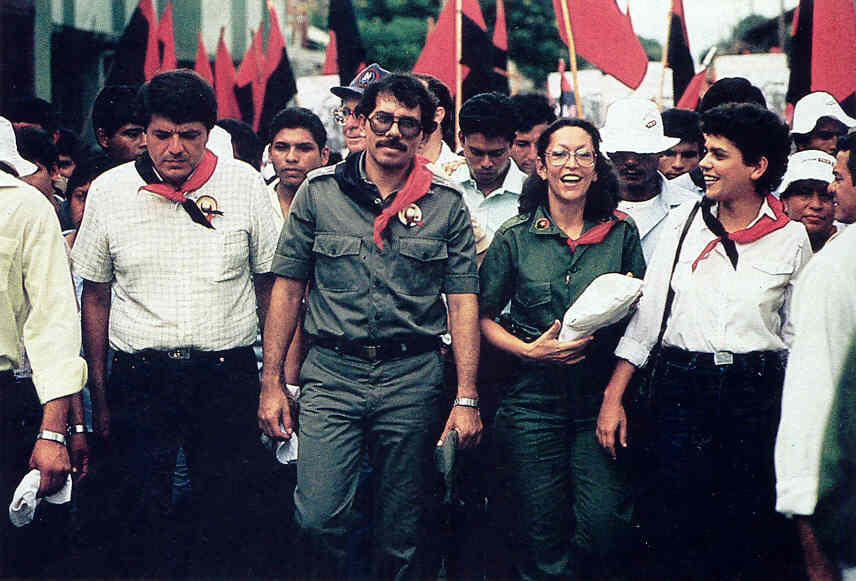
Nicaraguan President and
Sandinista leader, Daniel Ortega,
campaigning in support of his government
- 1984.
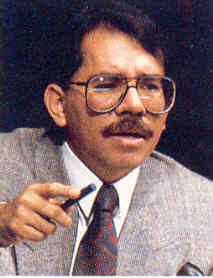
Sandinista leader Daniel
Ortega elected President of Nicaragua – 1985
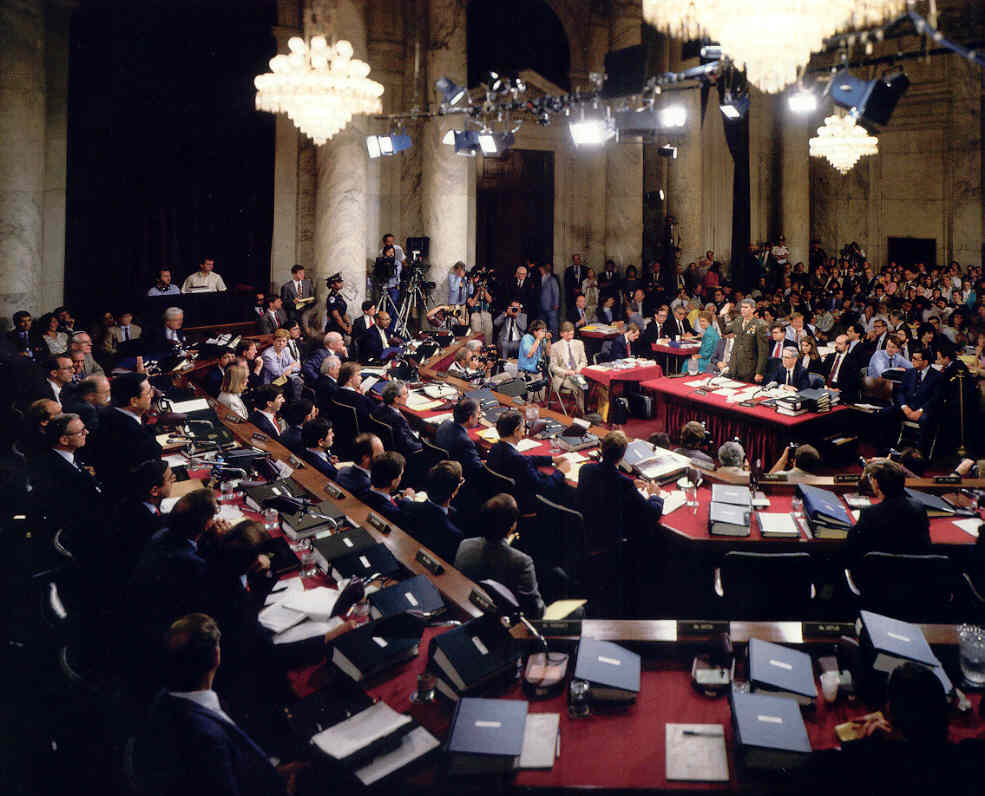
Lt. Col. Ollie North Testifying
before Congress in the Iran-contra affair – July 1987
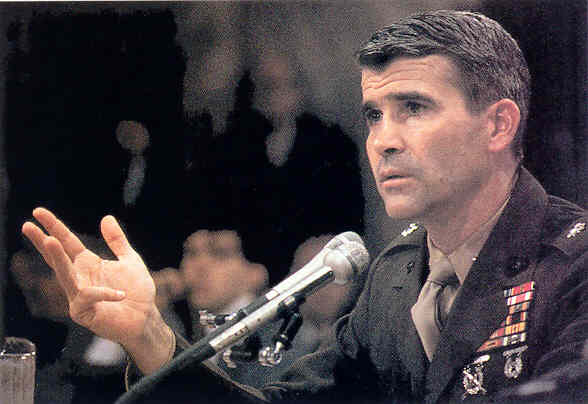
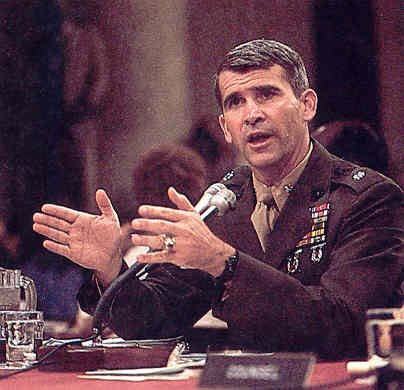
Oliver North testifying about
the Iran-Contra affair.
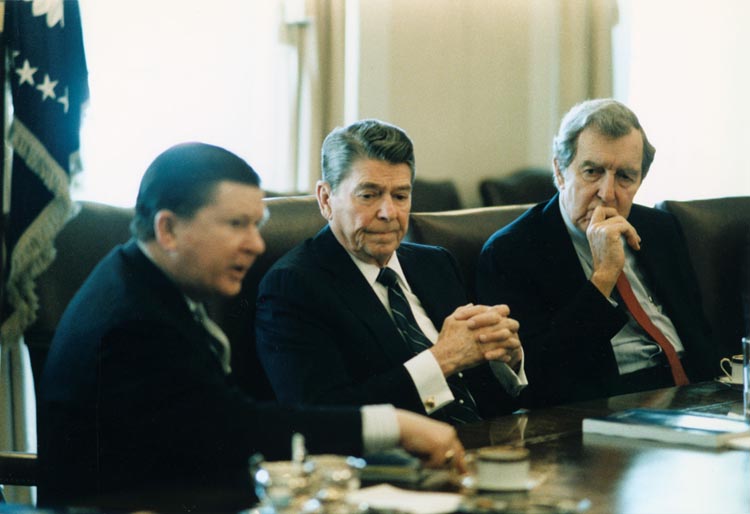
President Regan received
the Tower Commission Report in the Cabinet Room
with Senators John Tower
(l.) and Edmund Muskie (r.) attending – February 26, 1987.
CHINA BEGINS TO SELF-REFORM UNDER DENG XIAOPING |
|
Although the radical phase of Mao's Cultural
Revolution was over as China entered the 1970s (Army General Lin Biao
had been called in to settle the young Red Guards down and get things
back to work, Mao remained still very much in control of the Chinese
Communist Party (CCP). And the Idealism of the Cultural Revolution also
remained in place. According to Mao, the Chinese economy was not to be
run by party or government bureaucracy (as in Russia) nor by a
capitalist class (as in America) but from the commitment of the Chinese
people themselves to work toward high social goals – as outlined by Mao
himself, of course.
During the border conflict with the Russians in 1969, General Lin Biao
had taken on too much authority, and Mao purposely raised his long-time
friend, the political pragmatist Zhou Enlai to power, to counterbalance
the radical hardliner Lin's influence. Ultimately Lin overplayed his
hand (he was also very opposed to Zhou's opening up to the Americans)
and was killed in a plane crash as he was making an escape to Soviet
Russia in September of 1971. But soon Mao's actress wife Jiang Qing
took over Lin's position as the head of the CCP radicals.
In 1972 Mao suffered a stroke – and Zhou was diagnosed with cancer.
Thus the CCP moved to rehabilitate formerly-disgraced (and imprisoned)
Deng Xiaoping, as Zhou's possible heir. He too, like Zhou, was of the
pragmatist, not radical, political mindset. But this then stirred Jiang
Qing and some of her radical allies to counter-action. Things got tense
inside the party as Mao's struggle with his health intensified.
Then in January of 1976 Zhou died, and Mao replaced Deng with Hua
Guofeng (Hua was someone who stood somewhere in the middle of the
radicals and pragmatists). But then in September Mao died. And without
Mao's protection, Mao's wife Jiang and others of the radical "Gang of
Four" were arrested the following month. In the meantime, Hua tried to
make himself appear to the Chinese people as the spiritual successor to Mao.
But the CCP was moving step by step in the direction of the
pragmatists. Many of the three million officials purged during the
Cultural Revolution were slowly restored and gradually a number of
pragmatists were reinstated to the CCP Central Committee. At this
point, although Hua remained at the top executive post, the real power
behind the party was the restored Deng.
However Deng had evolved substantially in his thinking on economic
matters over the years, and had come to the realization that China
needed to open itself up to foreign investment in China and become
active in the global market (like Chinese Taiwan) if the Chinese
economy were ever to come to real growth. Thus in 1977 the Cultural
Revolution was declared over, and the next year Deng announced his Four
Modernizations program (agriculture, industry, science and defense).
Fourteen cities were designated as investment centers, with the idea of
opening the Chinese economy to foreign investment, to get the Chinese
economy back up and running again.
In 1980 and 1981 Hua was removed from some of his government positions,
and a number of party leaders were appointed instead to some of these
same positions. Deng took for himself only the position as chairman of
the Central Military Commission. Nonetheless from this position Deng
would hold tight control over Chinese politics during the entire 1980s.
In 1981 Jiang Qing and the other three members of the Gang of Four were
finally put on trial for treason. All four were convicted (death
sentences, soon reduced to life imprisonment) and the Maoist radical
wing of the Party was basically dismissed or silenced.
Deng now moved China toward his more "pragmatic" program of
market-based economic reform. Although the party and its bureaucracy
would still preside over matters, the actual initiative in the
development of the Chinese economy was directed toward the Chinese
themselves, especially among the more personally ambitious, much as in
the West's own market-driven system.
Deng's bringing the Chinese on board with his program at the
grass-roots level would produce amazing achievements, but ones however
that would fail to take hold elsewhere within the Communist or
Socialist world (including Russia, as we shall see below). Chinese
exports now began to grow rapidly. This occurred particularly because
China's new Western trading partners (who were strong supporters of
this Chinese economic transition to market economics) allowed the
official subsidizing of the Chinese currency exchange rate. This kept
the prices of Chinese products very low on the international market,
and the cost of foreign goods very high in China. This gave the Chinese
economy a major boost. Chinese industrialism now took off at incredible growth rates of around 8-10
percent annually during the 1980s and 1990s (although there was a dip
in 1989-1991).
|
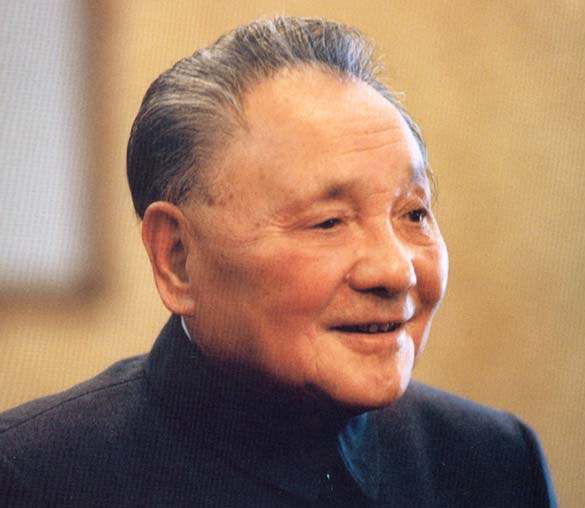
Deng Xiaoping
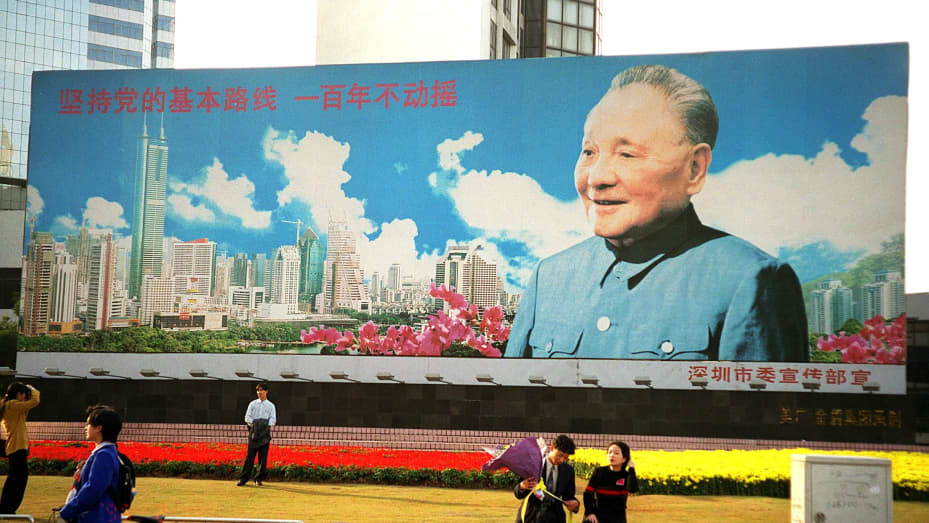
A huge billboard in Shenzhen celebrating Deng's economic reforms
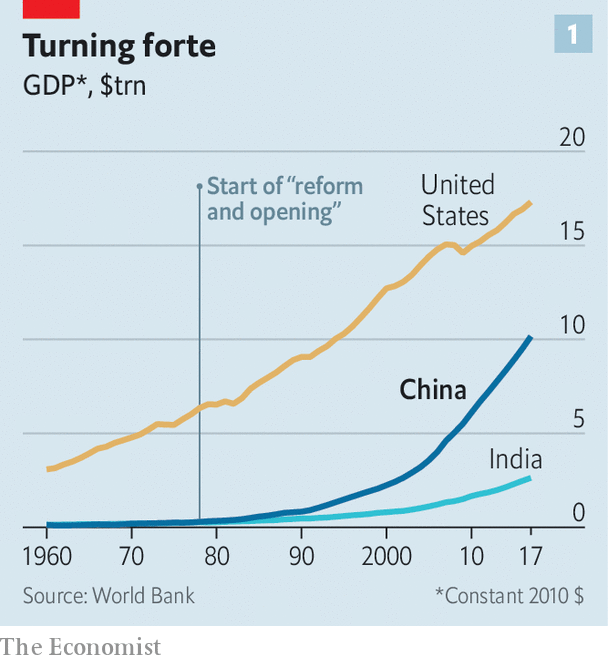
Comparative economic growth of US, China and India 1960-2017
THE RAPID DECLINE OF THE SOVIET EMPIRE |
|
Economic and social crisis in the Soviet Union
A
similar social-economic crisis had hit Soviet Russia during the 1970s,
but unlike China, it continued into the 1980s. And also unlike China,
Soviet Russia would not find a successful path out of this crisis.
Soviet farming had never done well since the days of Stalin's forced
collectivization, and Russia, once a major exporter of grain, long had
to import grain to feed its people, a great burden on its foreign
currency reserves. Also the high cost of Soviet armaments had long cut
into the ability of the state to offer its people a level of civilian
material housing and comforts that a "workers' paradise" should have
had. Most Soviet workers knew well that their worker counterparts in
the capitalist West lived much better off than they did. In the Soviet
Union, the workers' paradise had the feel of a Third World country.
This in turn was creating a decided drop in "working class patriotism"
which was taking the form of a large amount of worker absenteeism at
the job site, and even when workers did show up, it was not unusual for
them to be drunk. The Soviet economy was in trouble, big trouble.
The one thing Russia had in ample supply that was greatly needed abroad
and could bring in hard currency to finance Soviet economic
shortcomings was oil (and eventually also natural gas). Thus the Soviet
Union's decision in 1981 to break from the oil pricing of the OPEC oil
cartel and sell oil, lots of oil, for whatever price it could get. And
with the underbidding of oil pricing by the Soviets, the price of oil
came tumbling down.
Thus the Soviets would not reap the windfall profits from oil that they
had been hoping for. Indeed, many of the oil exporting nations now also
found themselves in difficulty as their expected revenue from oil
dropped away and they had to cut back drastically on investment plans
for growth.
The Soviet quagmire in Afghanistan
In Soviet Russia things continued
to go from bad to worse. The Muslim revolution in Iran had quickly
spilled over into neighboring Afghanistan in the early 1980s as Afghani
Muslims answered the call to jihad (the struggle against Evil) against
the Soviets and their puppet Communist regime in Kabul. At the same
time, America did not want the Soviets occupying Afghanistan, a point from which they
could put pressure on the Persian Gulf region (the major source of the
West's oil). Consequently, America undertook to supply the Afghan
rebels (the mujahedin) with advanced missiles that could easily kill
Soviet tanks and jets. The Soviets were finding themselves bogged down
in a war that, even with a massive military presence in the country,
they could not bring to a favorable close. It was as if Afghanistan
were the Soviets' "Vietnam." Soon anti-war feelings began to grow
within Russian society, and even within the military itself. Russia was
in deep trouble in Afghanistan.
Thus by the early 1980s Soviet morale was sagging terribly, at a time
when America's was picking up. Finally in 1988 the decision was made to
withdraw from Afghanistan, the task completed by early 1989.
The rapid turnover in Soviet leadership (1982-1985)
When Brezhnev died
in late 1982, he was replaced as head of the regime by a KGB (Soviet
secret police and intelligence operations) hardliner, Yuri Andropov.
Andropov tried to tighten party discipline and clamp down on the
political dissent that was spreading rapidly around the country. But
his health was failing and only a little over a year later he died. He
was replaced by another equally sick official, Konstantin Chernenko,
who served as Soviet leader no more than a year before he too died. But
this time Soviet leadership was taken over by a younger and strongly
reform-minded Mikhail Gorbachev, who knew that something dramatic was
going to have to take place to save the Soviet Union from simply
collapsing.
Reagan meanwhile had been stiffening his
position against the Russians, announcing back in 1982 in a speech
before the British Parliament how he intended to push the Russian "Evil
Empire" to the point of collapse. He put the B1-Bomber program back in
place (which Carter had canceled), armed NATO with America's Pershing
II missiles, and in 1983 announced a plan (the Strategic Defense
Initiative)2 to develop a laser-guided anti-missile defense system that
would block incoming nuclear missiles, thus undercutting the Soviet
nuclear deterrent. It would be expensive, at least expensive enough
that the Soviets, whose economy was stumbling at this point, would be
unable to answer the challenge with a countering program of their own.
But in general, the American population was quite approving of Reagan's
new "Star Wars" program. But in the end, the program would not really
be needed, for the Soviet Empire crumbled before the decade was out.
But mostly this challenged Russia in a way that the new Soviet Premier Mikhail Gorbachev knew that his country could
not effectively answer. Gorbachev responded instead by offers of a new
look to the Soviet Union and a new attitude toward the West.
Reagan, while carrying Teddy Roosevelt's "Big Stick" (his ramping up
of America's defense posture) was also ready to follow Roosevelt's
policy of "walking softly" with respect to the Soviet Union's new
leader Gorbachev. Reagan began to meet with Gorbachev to see what
possibilities existed to develop a new thaw in East-West relations
(similar to what was happening in U.S.-Chinese relations at that point).
In 1986, Gorbachev began to put into operation a number of social
reforms for Russia, the most important of which were glasnost (a new
openness in the society), perestroika (a restructuring of the economic
system) and demokratizatsiya (democratization of the political system).
This was designed to put a new lease on life in Communist culture.
Gorbachev's reforms were greeted with great enthusiasm everywhere – in Russia, in Eastern Europe and even in America.
But for Reagan, this was not yet enough. In June of 1987, as he stood
before the Berlin Wall at the Brandenburg Gate, Reagan uttered a
challenge which would have a dramatic impact on everyone:
. . . if you truly want peace and liberalization, Mr. Gorbachev, open this gate! Mr. Gorbachev, tear down this wall!
The gate did not open right away. The wall was not torn down right
away. But things were now headed that way. In the last years of his
administration, Reagan had become a fond friend of Gorbachev, visiting
back and forth between America and Russia. Reagan truly wanted to
support Gorbachev in his effort to reform Russia.
But in the process Gorbachev had set loose in the Soviet Union a small
opportunity for the revolution of rising expectations to take root.
Could he reform Russia without having it break down in revolutionary
chaos in the process?
The answer to that question would reveal itself soon after the new
American presidential administration under Reagan's Vice President,
George H.W. Bush, got underway in 1989.
2Termed derisorily by Kennedy as Reagan's "reckless Star Wars schemes."
|
Reagan challenges the cash-short
Soviets to another round in the arms race
with the introduction of the
"Star Wars" strategy
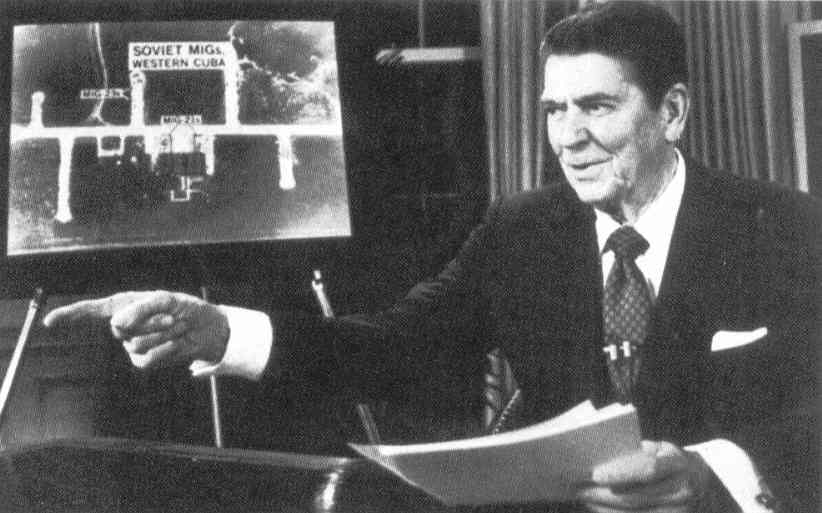
In a televised speech, Reagan
reveals his Strategic Defense Initiative
or "Star Wars" plan – March 23,
1983
A political stirring is rising in the
Soviet empire in East Europe
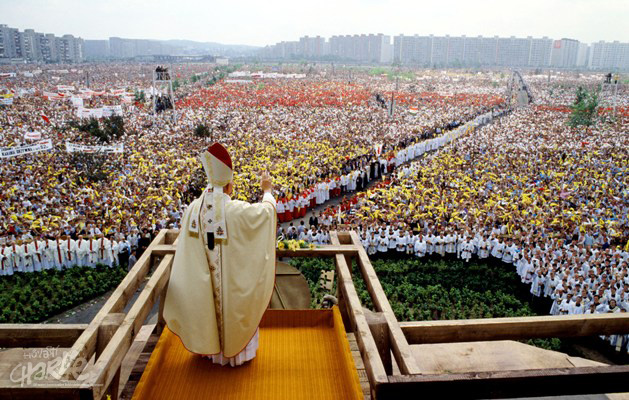
The huge Polish reception
to Pope John Paul II's visit in June of 1979
constituted a huge challenge
to the authority of the Polish Communists
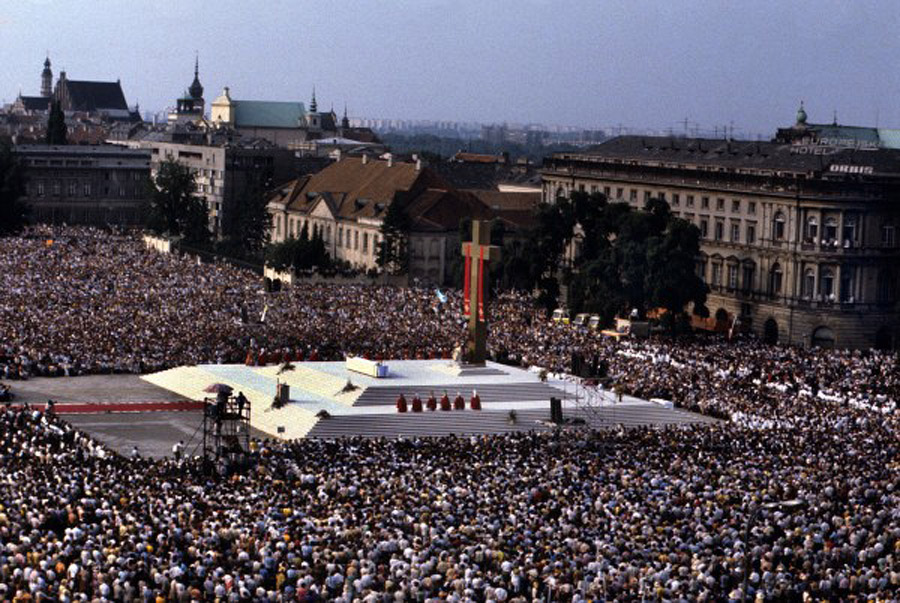
Then, led by Lech Walesa's and his dock-workers' union "Solidarity,"
Polish workers give serious
affront to the Communist system in Poland 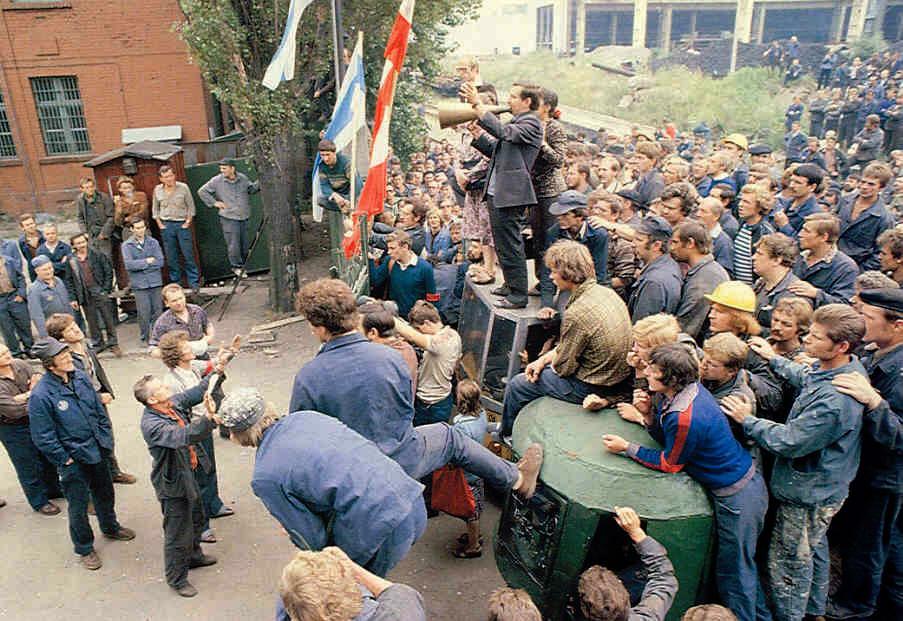
Lech Walesa leading the strike
of workers at the Lenin Shipyards in
Gdansk, Poland – August 30, 1980 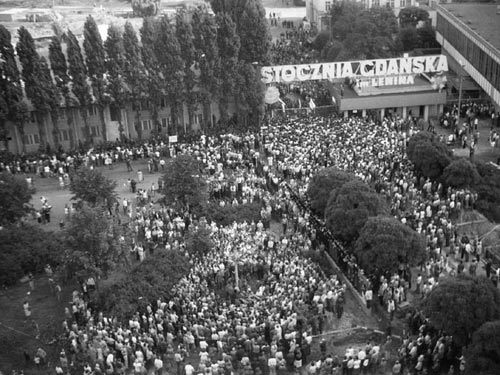
Striking workers at the Lenin
Shipyard – 1980
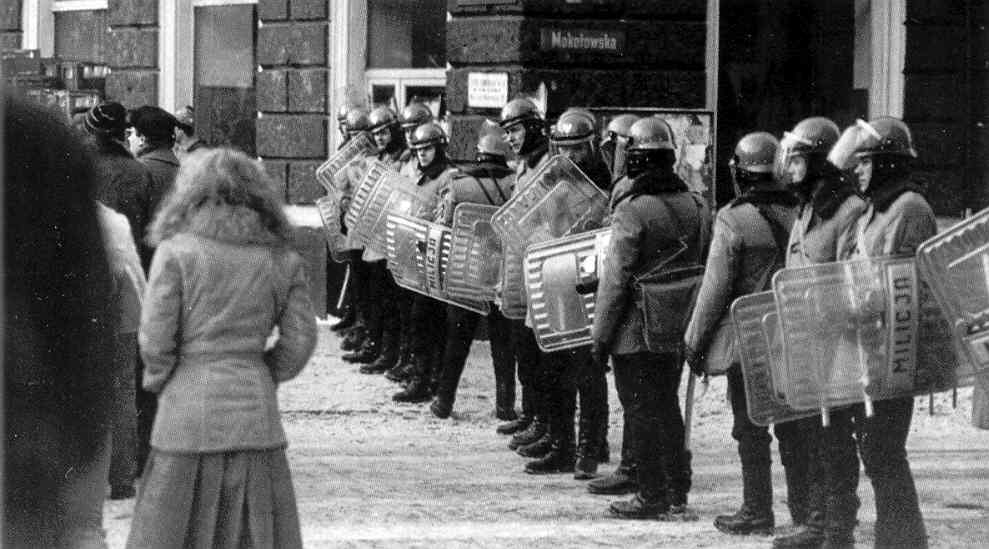
Polish military under Gen.
Jaruzelski, fearful of a Soviet military reprisal (such as occurred in
Czechoslovakia in 1968), retake Poland from Solidarity – December 1981
But things are also stirring in the Soviet Union, as the Soviet Empire's leadership
changes hands rapidly over the course of the early-to-mid 1980s
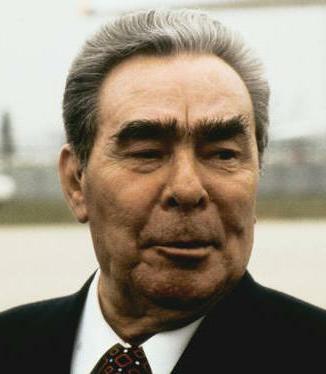 Leonid Brezhnev
Leonid Brezhnev
Communist Party Chairman
1964-1982
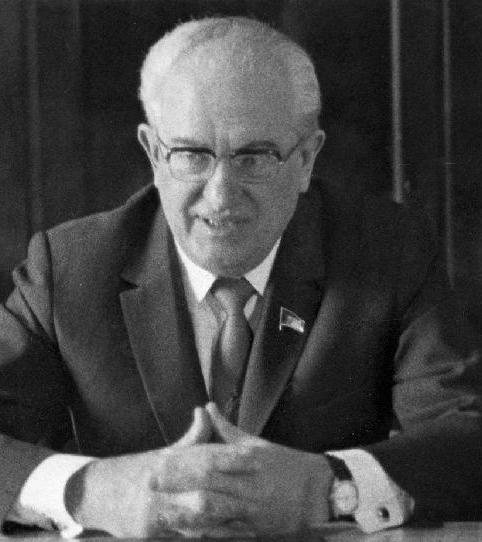 Yuri Andropov
Yuri Andropov
Communist Party Chairman
1982-1984
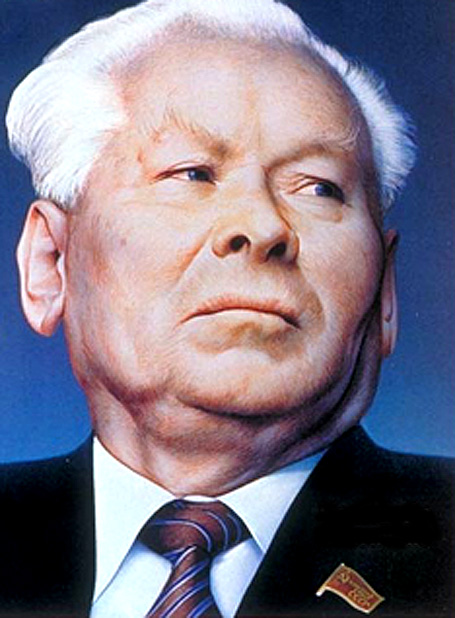 Konstantin Cernenko
Konstantin Cernenko
Communist Party Chairman
1984-1985
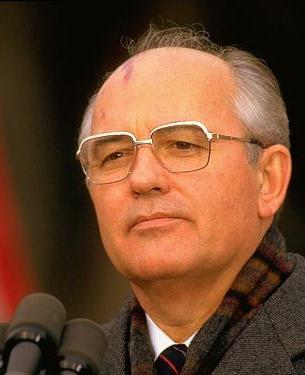 Mikhail Gorbachev
Mikhail Gorbachev
Communist Party Chairman
1985-1991
Also ... the Soviet position in Afghanistan begins to come apart (early 1980s)
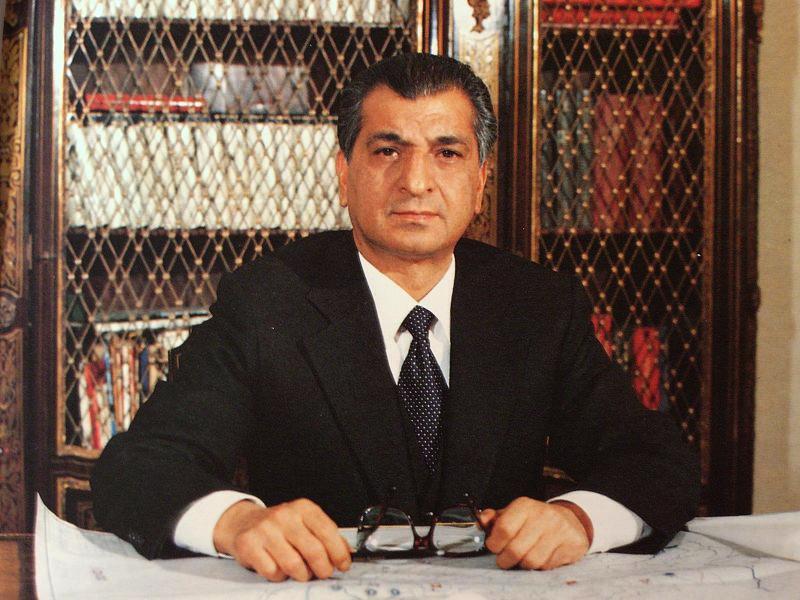 Babrak Karmal
chairman of the Revolutionary Council of the Democratic Republic of Afghanistan
(1979-1986). The Soviets had installed
this Afghan Communist leader in Kabul in 1979 in the hopes
that he might
keep more effective control over Afghan politics than had
his Communist predecessor, Hafizullah Amin – whom Soviet troops assassinated
when they first invaded the country in 1979.
Babrak Karmal
chairman of the Revolutionary Council of the Democratic Republic of Afghanistan
(1979-1986). The Soviets had installed
this Afghan Communist leader in Kabul in 1979 in the hopes
that he might
keep more effective control over Afghan politics than had
his Communist predecessor, Hafizullah Amin – whom Soviet troops assassinated
when they first invaded the country in 1979.
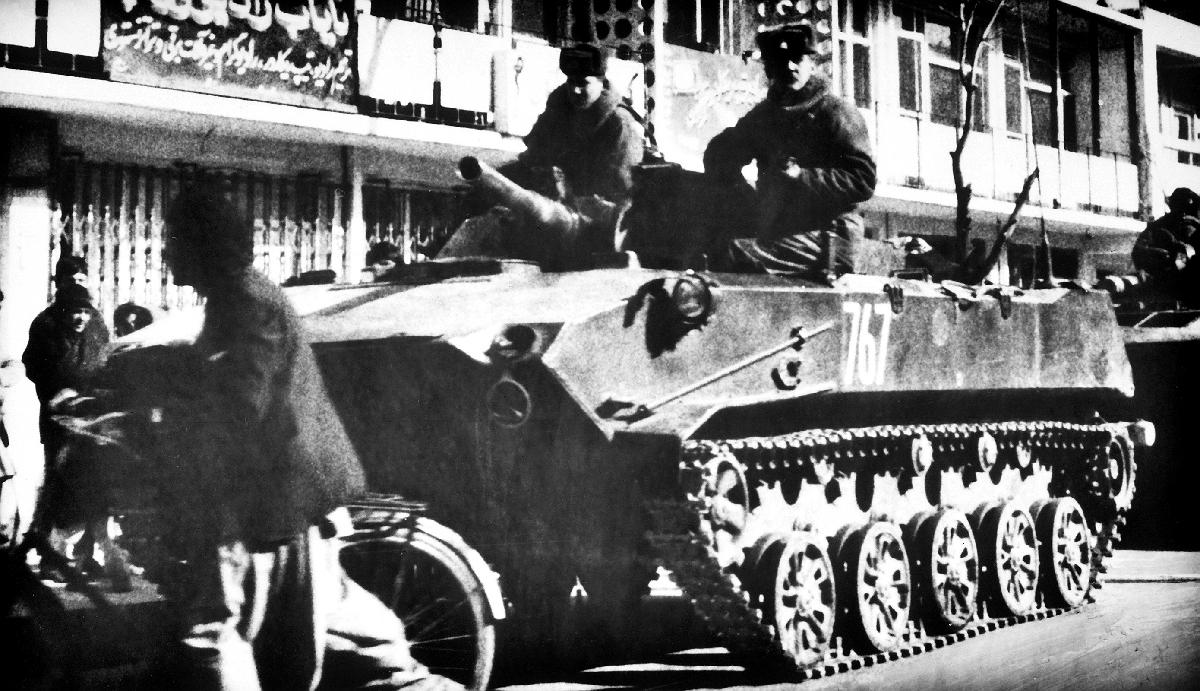
Soviet paratroopers aboard
a BMD-1 in Kabul
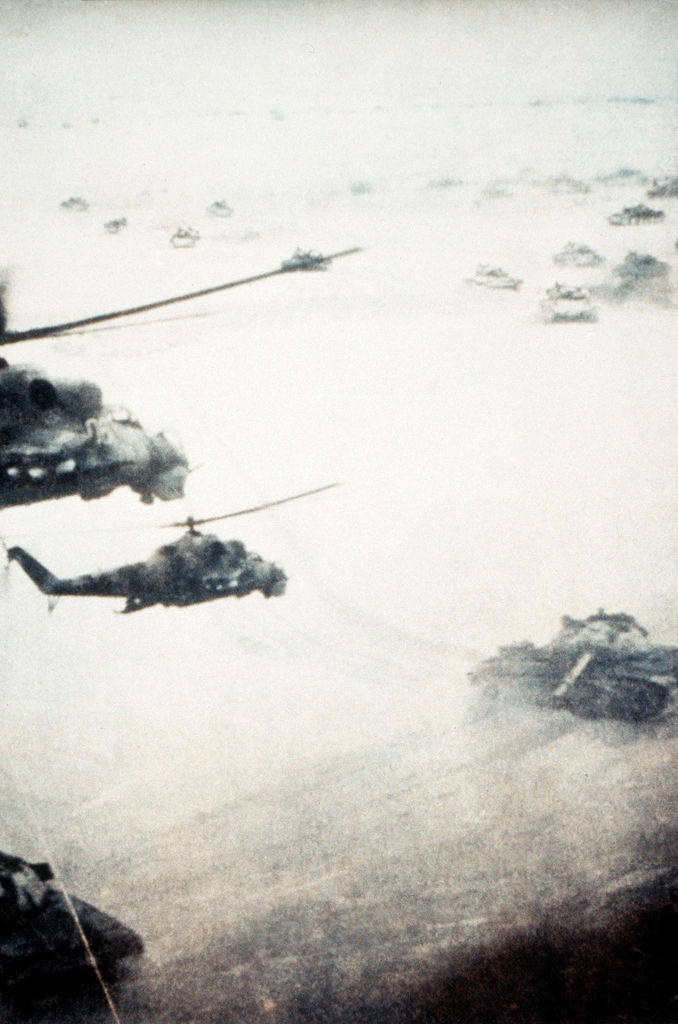
Soviet helicopters working
with Soviet tanks in Afghanistan
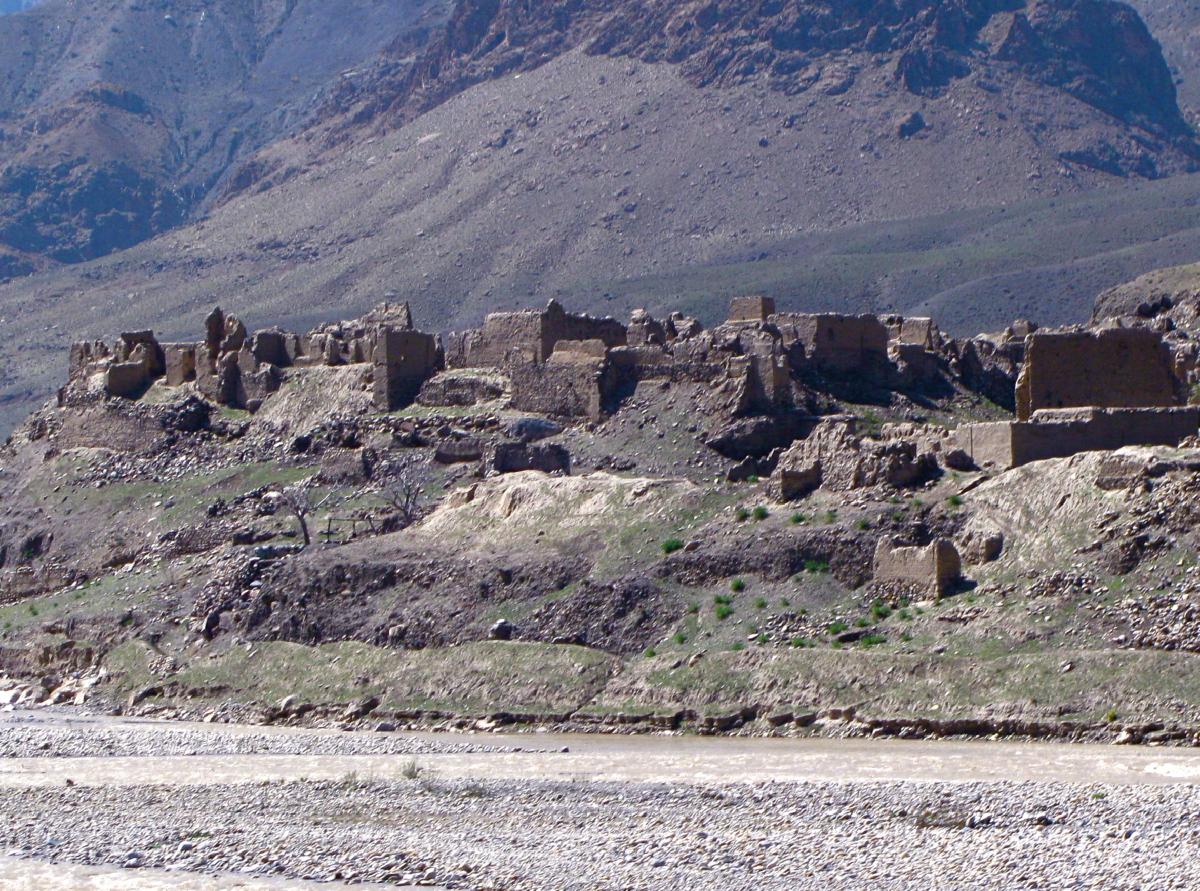
Afghan village destroyed
by Soviet troops
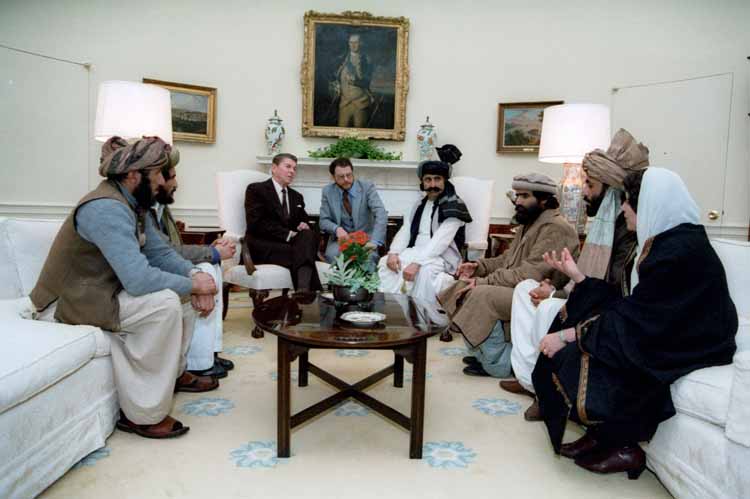
Reagan listening to the
mujahidin's
description of Soviet atrocities in Afghanistan – February 1983

Texas Congressman Charlie
Wilson in Afghanistan
Wilson was a prime mover
in Operation Cyclone, in which the US sent $ millions to support the
mujahidin in their fight against the
Soviets (unfortunately much of the money ended up in corrupt Pakistani
military hands). Resistance by conservative
Muslim mujahidin however is grinding down the Soviet effort to maintain Communist control
in Afghanistan.
|
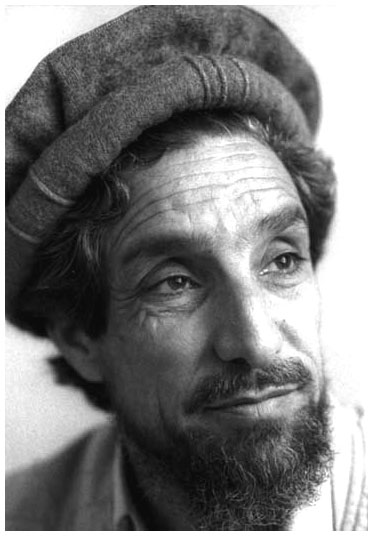 Ahmad Shah Massoud – the
"Lion of Panjshir"
Ahmad Shah Massoud – the
"Lion of Panjshir"
|
This
engineer-turned-mujahidin
proved to the the most effective of the Afghan resistance commanders. When the Taliban later
took over the country, he became their prime opponent. The Taliban
assassinated him just days before the September 11, 2001 attack
on the New York Twin
Towers)
|
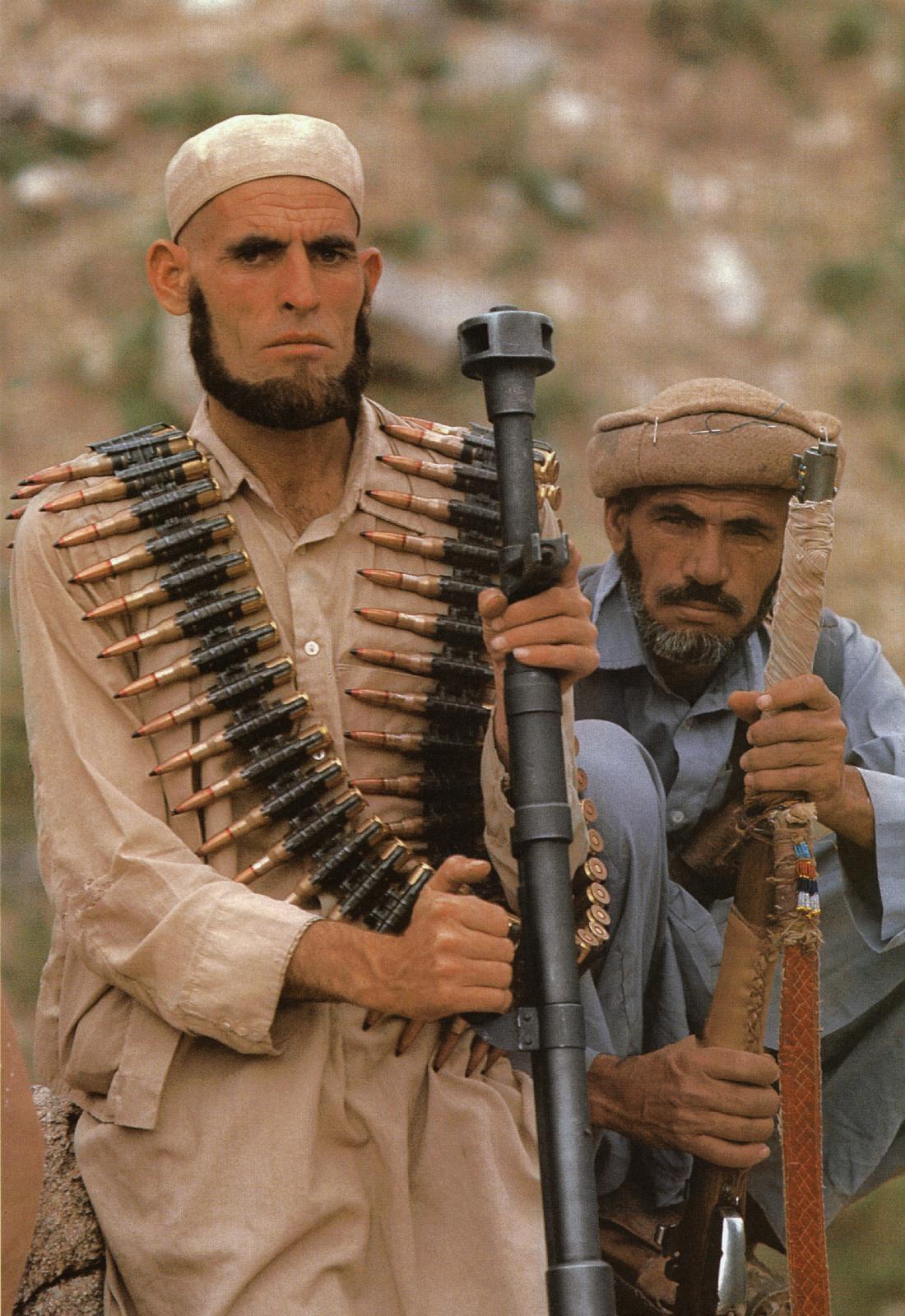
Well armed mujahedin
confronting
Soviet troops in Afghanistan
The new Soviet leader Gorbachev was pushing for a new face
to Communism
with the policies of perestroika (economic reform), glasnost (personal freedom),
and demokratizatsiya (democratization)
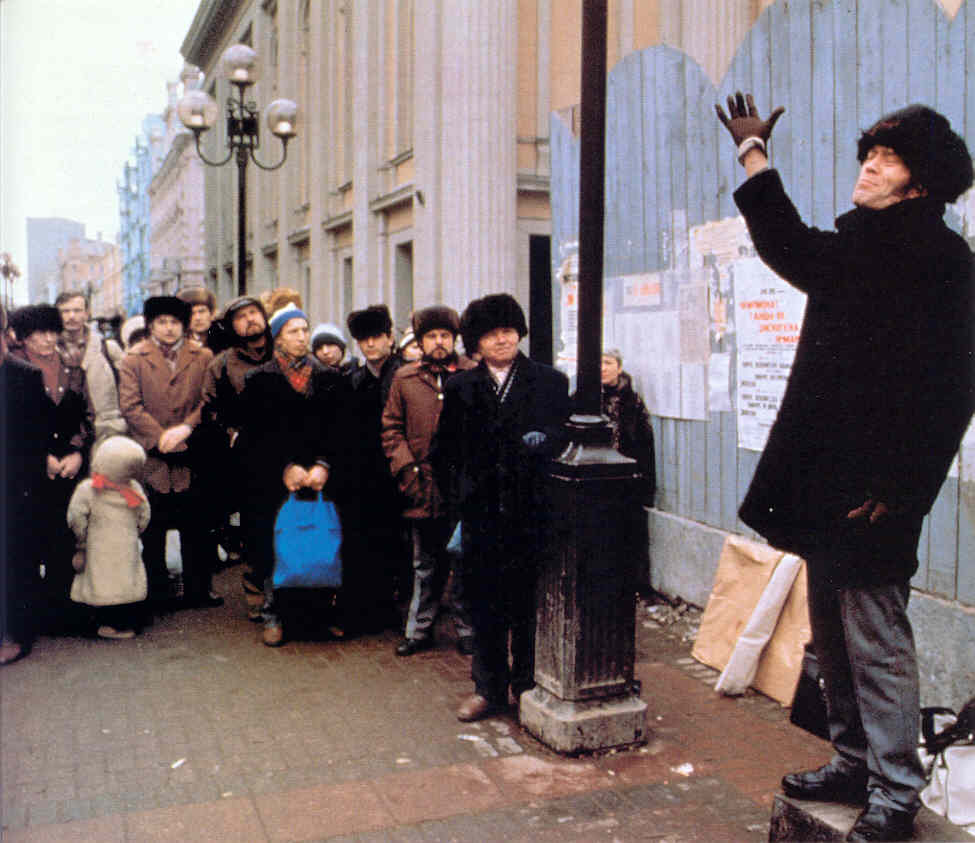
A Russian practicing
glasnost
on a Russian street
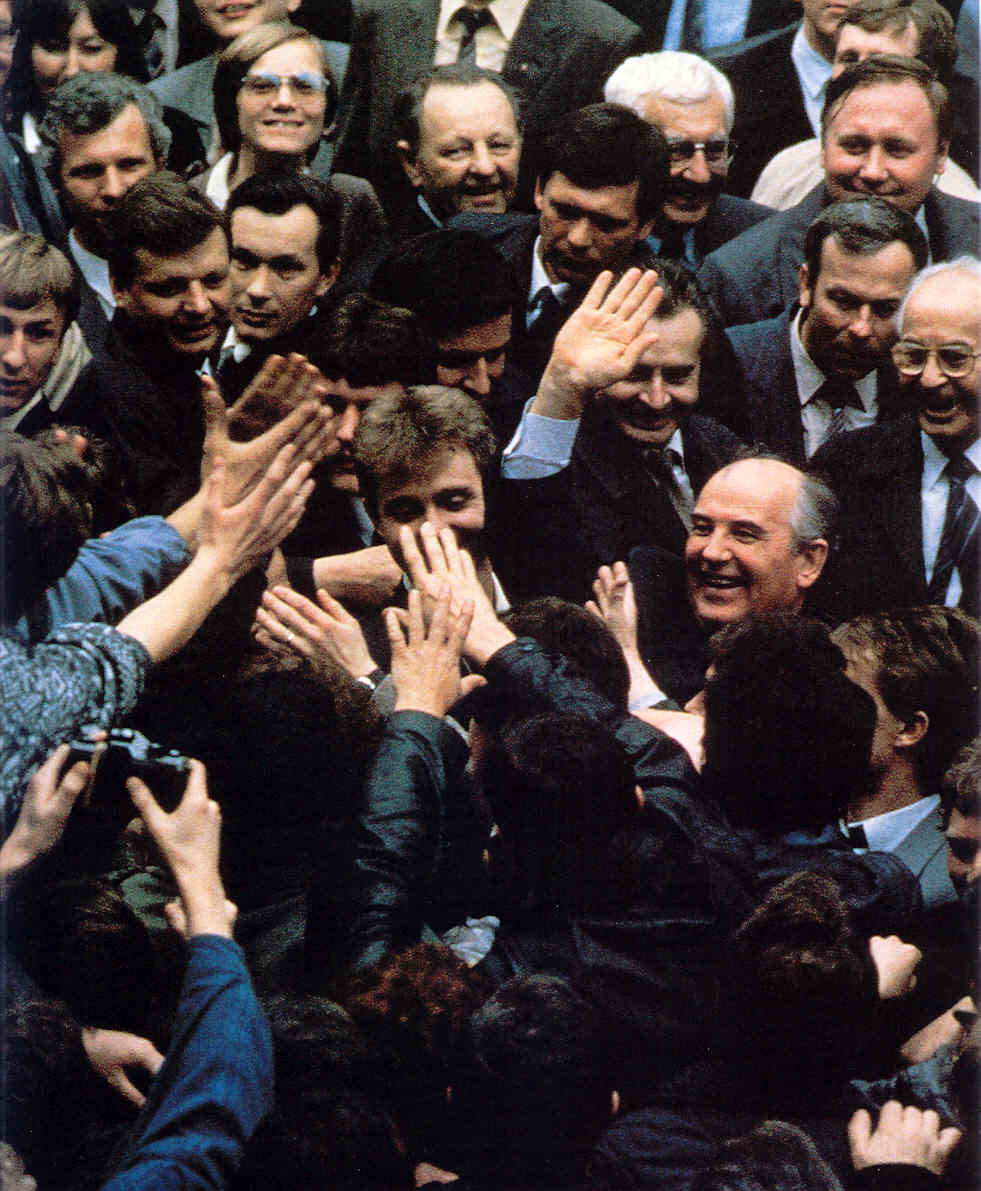
Gorbachev welcomed in Prague
for his reforms
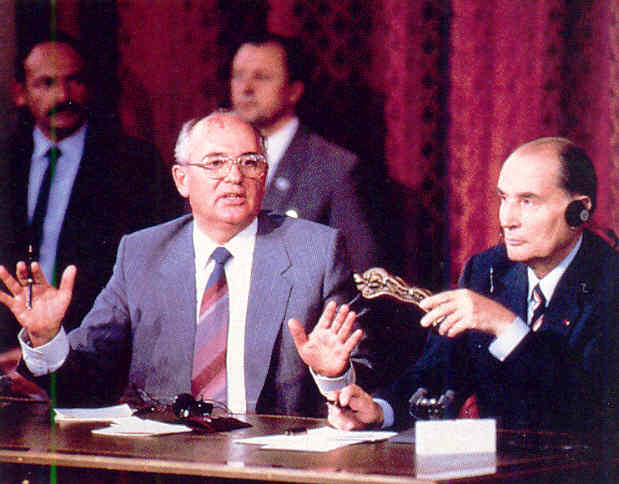
Soviet Premier Gorbachev
meets with French President Mitterrand in Paris – 1985
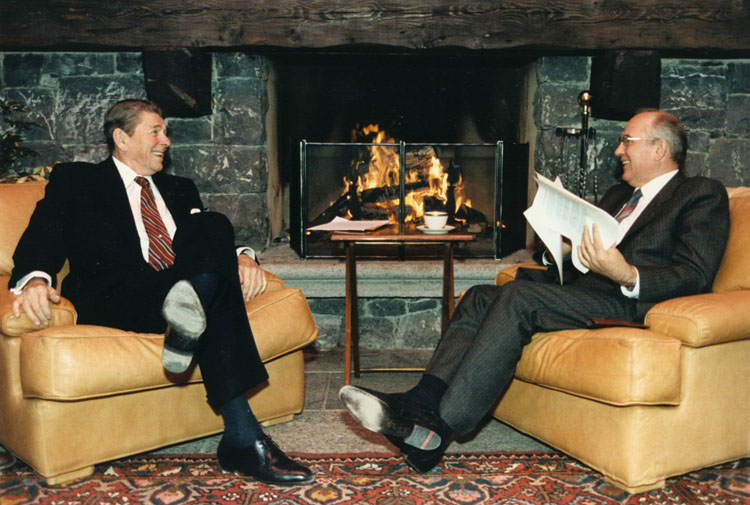
Reagan and Gorbachev at the
first Summit in Geneva, Switzerland – 19 November 1985
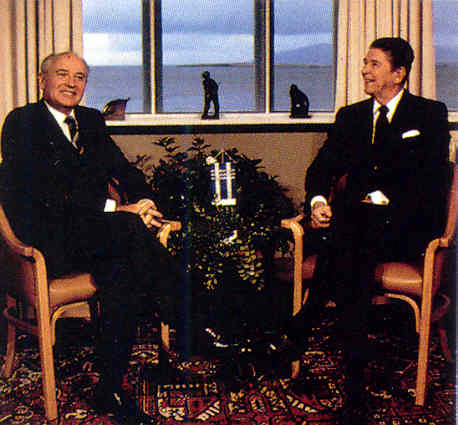
Gorbachev and Reagan meet
in Reykjavik, Iceland – autumn 1986
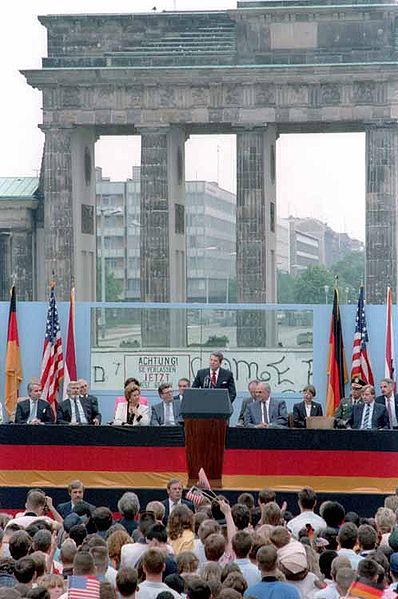 "Mr. Gorbachev, tear down
this wall!" – June 1987
"Mr. Gorbachev, tear down
this wall!" – June 1987
Gorbachev, realizing that the Afghan War was merely weakening further the Soviet strategic
position globally, decides to call it quits in Afghanistan – July 1987

Soviet Commander Boris Gromov
announcing the Soviet troop pullout from Afghanistan – July
1987
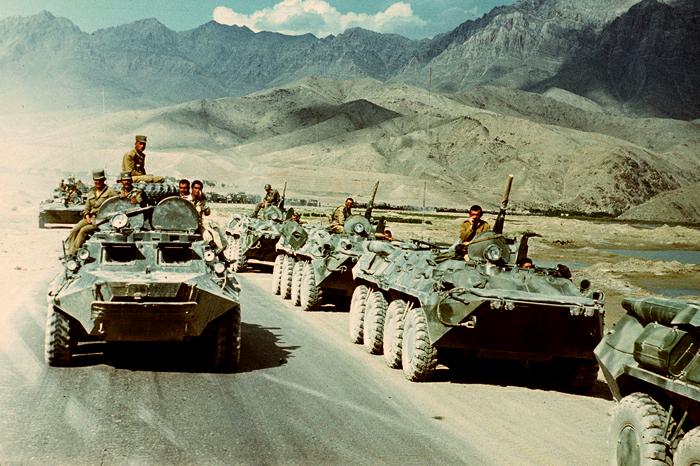
Afghan troops (on the left)
watching Soviet troops leaving Afghanistan – 1988
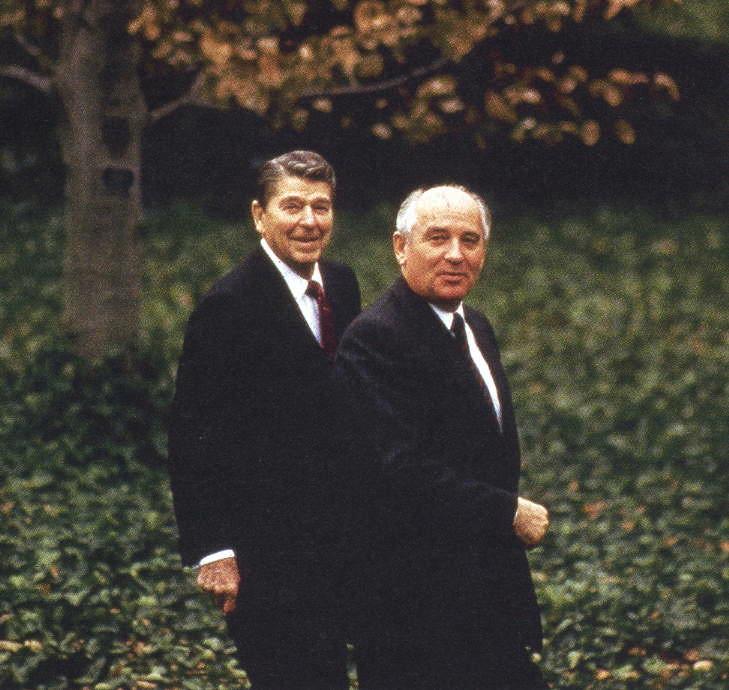
Gorbachev with Reagan on
a summit visit to Washington – 1987
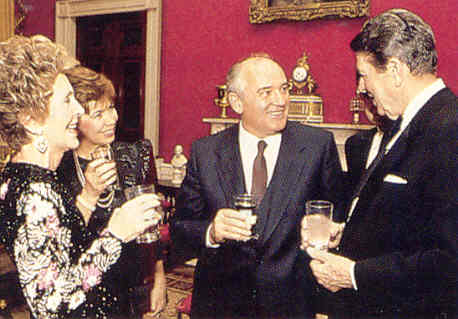
The Gorbachevs visit the
Reagans in Washington – December 1987
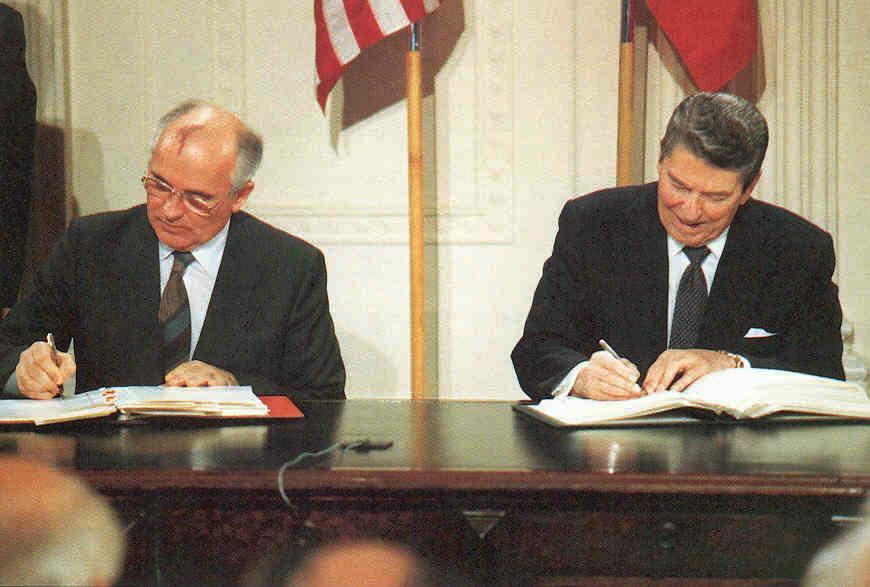
Gorbachev and Reagan sign
the Intermediate Nuclear Forces (INF) Treaty in Washington – 1987
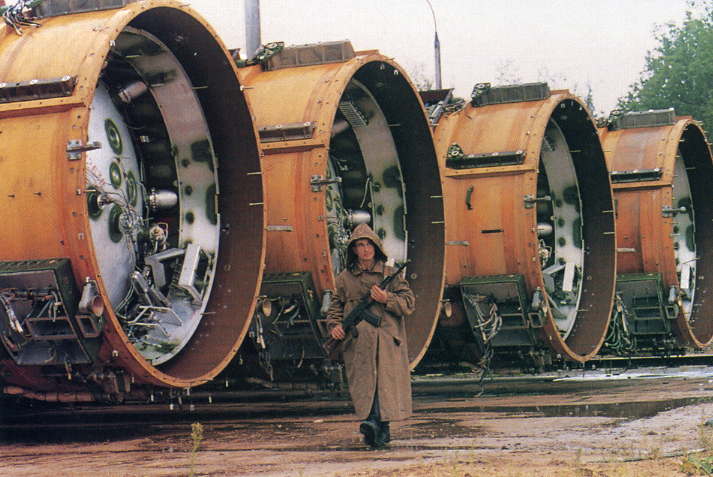
A Soviet sentry guarding
ICBMs scrapped under a 1987 disarmament treaty with the US
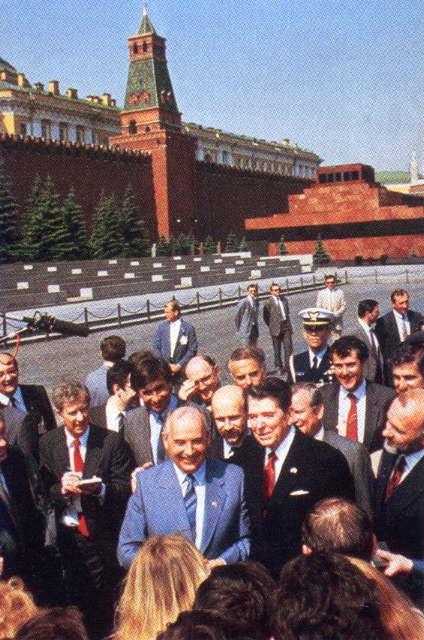 Gorbachev and Reagan in Moscow
- 1988
Gorbachev and Reagan in Moscow
- 1988
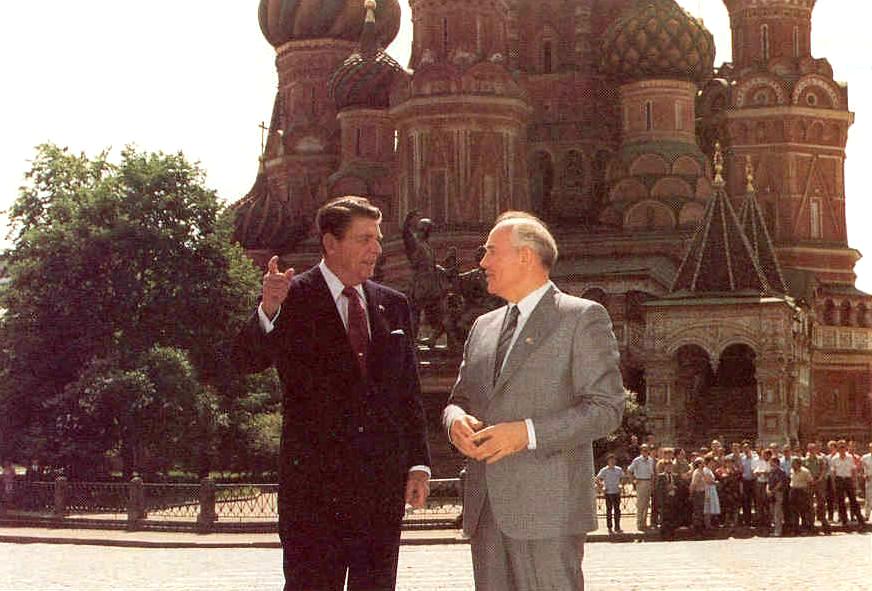
President Ronald Reagan visiting
with Soviet Premier Mickail Gorbachev in Moscow,
chatting in front of St.
Basil's Cathedral on Red Square
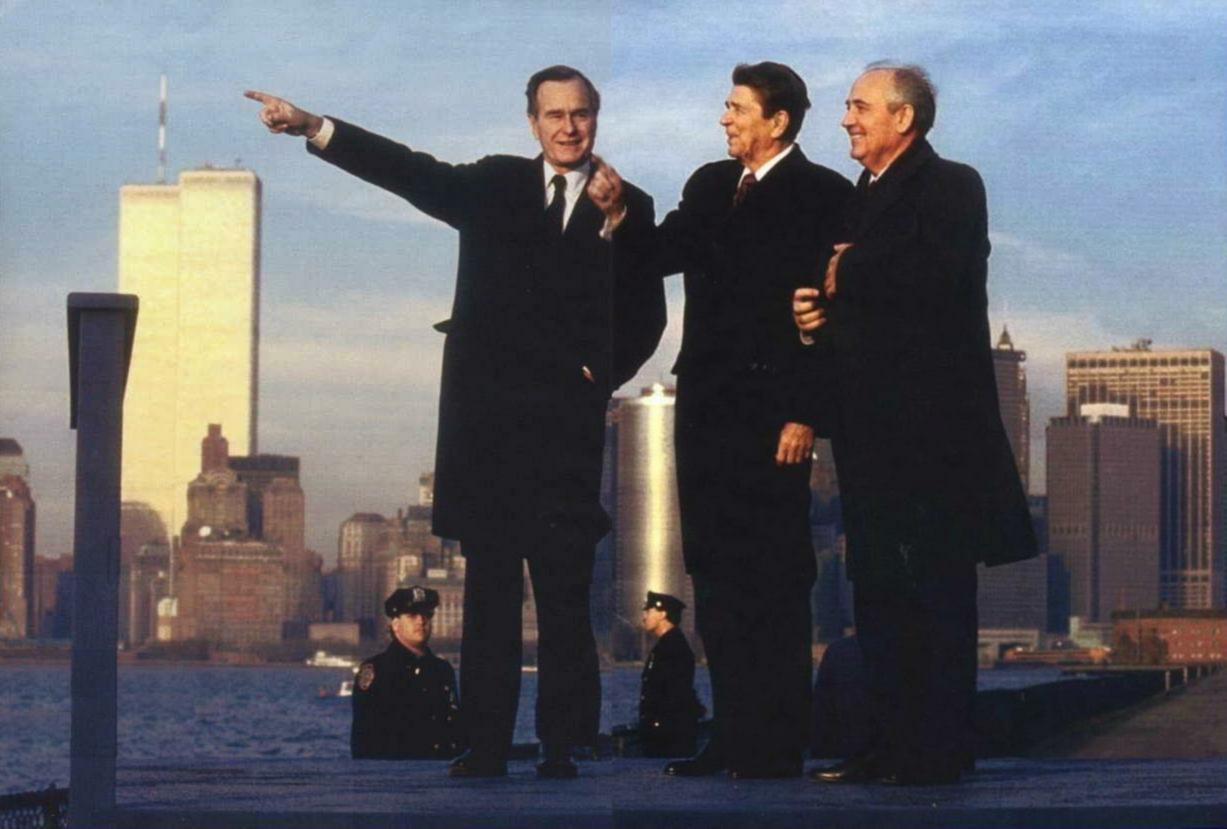
Soviet Premier Gorbachev
visiting Reagan and Bush in New York shortly after the latter's
electoral victory in 1988
ANOTHER EVENT ADDS A STRONG TOUCH OF TRAGEDY
TO THE REAGAN YEARS |
On January 28, 1987 the space shuttle
Challenger exploded soon after launch -- killing all 7 crew-members aboard.
|
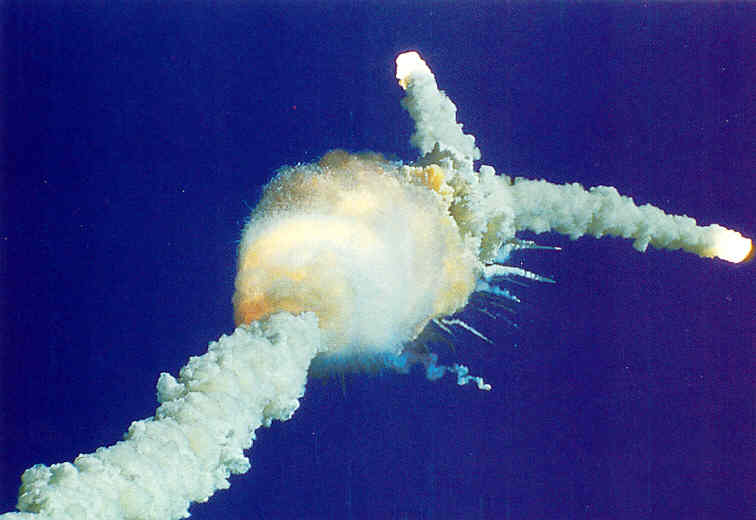

Go on to the next section: Bush (Sr.) and the World
 Miles
H. Hodges Miles
H. Hodges
| |


 Troubles in the Middle East
Troubles in the Middle East
 The Iran-Contra affair threatens to pull
The Iran-Contra affair threatens to pull China begins to self-reform under Deng
China begins to self-reform under Deng The rapid decline of the Soviet Empire
The rapid decline of the Soviet Empire
 Another
event adds a strong touch of
Another
event adds a strong touch of











































